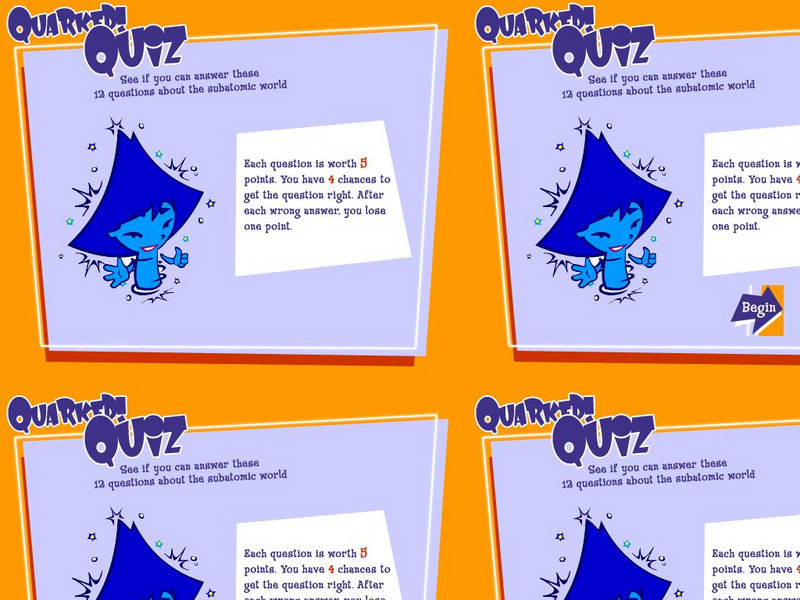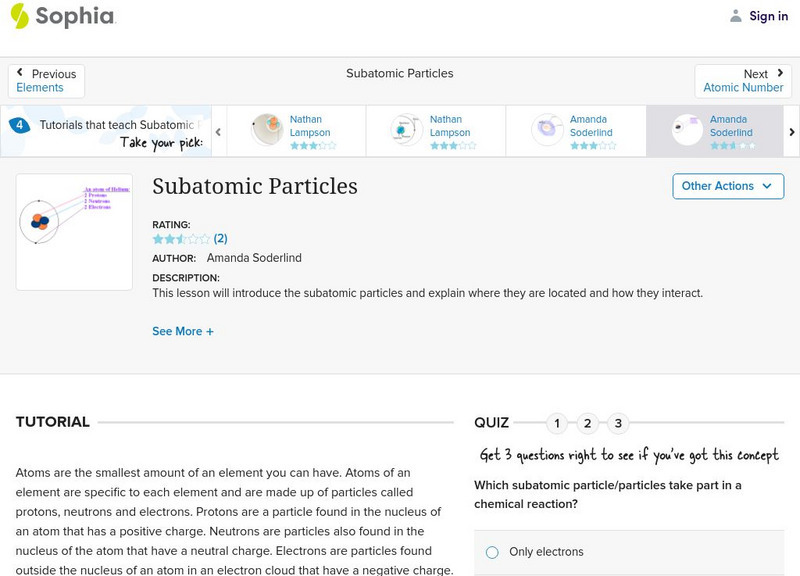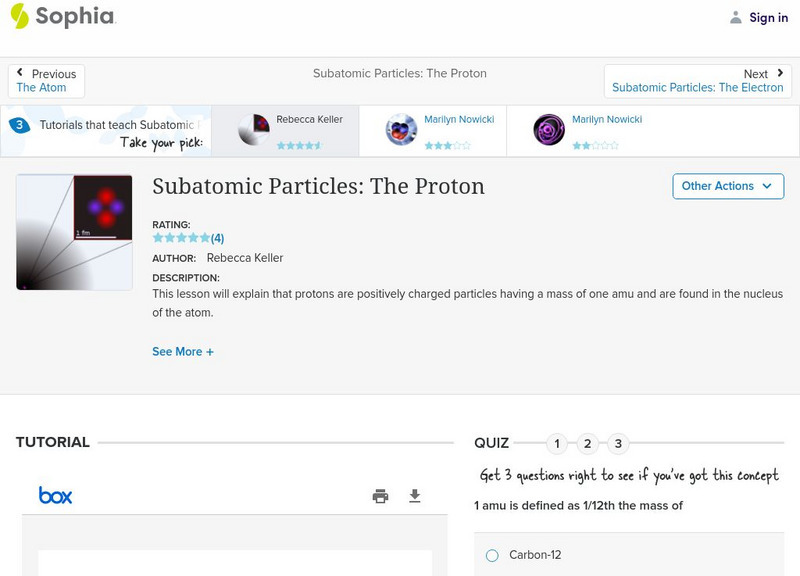Other
University of Kansas: Quarked!: Baryon Blaster
Try to fill each SUV with the right kinds of quarks as it travels across the screen, in order to make different types of baryon particles. The game becomes more challenging as you progress through the levels.
Other
University of Kansas: Quarked!: How Tall Are You?
Enter your height using inches or meters, and see how tall you are in units, from as tall as the Statue of Liberty and an elephant, down to atoms and quarks. Next, see if you can put the Quarkster characters and yourself in order by height.
Other
University of Kansas: Quarked!: Quiz
A twelve-question quiz about quarks and other subatomic particles, with links to games and other activities on the website.
Other
University of Kansas: Quarked!: Subatomic Match
Match the Quarkster characters by identifying which of six different traits and three colors they have in common.
Other
University of Kansas: Quarked!: Rummy
A card game where you must combine different types of quarks in order to make baryon particles, or to make particle decay chains.
Other
University of Kansas: Quarked!: Ushi's Ruler Game
See how many times a paper ruler must be cut in half before it reaches the size of a quark.
Other
University of Kansas: Quarked!: Word Search
A word search with vocabulary related to the study of subatomic science.
Sophia Learning
Sophia: Subatomic Particles: Lesson 2
Describe the $ifference between the subatomic particles, including their masses, locations, and charges. This lesson is 2 of 7 in the series titled "Subatomic Particles."
American Chemical Society
Middle School Chemistry: Protons, Neutrons, and Electrons
Explore the particles that make up atoms: protons, electrons, and electrons.
CK-12 Foundation
Ck 12: Physical Science: Atoms
[Free Registration/Login may be required to access all resource tools.] Atoms and how they are related to elements, and the particles that make up atoms.
Sophia Learning
Sophia: Subatomic Particles: Lesson 3
This lesson will introduce the subatomic particles and explain where they are located and how they interact. It is 3 of 7 in the series titled "Subatomic Particles."
Sophia Learning
Sophia: Subatomic Particles: Lesson 4
This lesson will introduce the subatomic particles and explain where they are located and how they interact. It is 4 of 7 in the series titled "Subatomic Particles."
Sophia Learning
Sophia: Subatomic Particles: Lesson 6
This lesson will introduce the subatomic particles and explain where they are located and how they interact. It is 6 of 7 in the series titled "Subatomic Particles."
Sophia Learning
Sophia: Subatomic Particles: Lesson 7
This lesson will introduce the subatomic particles and explain where they are located and how they interact. It is 7 of 7 in the series titled "Subatomic Particles."
Sophia Learning
Sophia: Subatomic Particles: Lesson 5
Describe the difference between the subatomic particles, including their masses, locations, and charges. This lesson is 5 of 7 in the series titled "Subatomic Particles."
Sophia Learning
Sophia: Subatomic Particles: The Electron: Lesson 3
This lesson will explain that electrons are negatively charged particles with negligible mass and are found in pairs in orbitals surrounding the nucleus of an atom. It is 3 of 3 in the series titled "Subatomic Particles: The Electron."
Sophia Learning
Sophia: Subatomic Particles: The Proton: Lesson 2
This lesson will explain that protons are positively charged particles having a mass of one amu and are found in the nucleus of the atom. It is 2 of 3 in the series titled "Subatomic Particles: The Proton."
Sophia Learning
Sophia: The Atom: Lesson 2
This lesson will illustrate that an atom is mostly empty space and has a positively charged, massive core (containing both protons and neutrons called the nucleus) surrounded by negatively charged electrons. It is 2 of 3 in the series...
Sophia Learning
Sophia: Subatomic Particles: The Neutron: Lesson 2
This lesson will explain that neutrons are particles in the nucleus that have no charge and a mass of one amu. It is 2 of 3 in the series titled "Subatomic Particles: The Neutron."




















